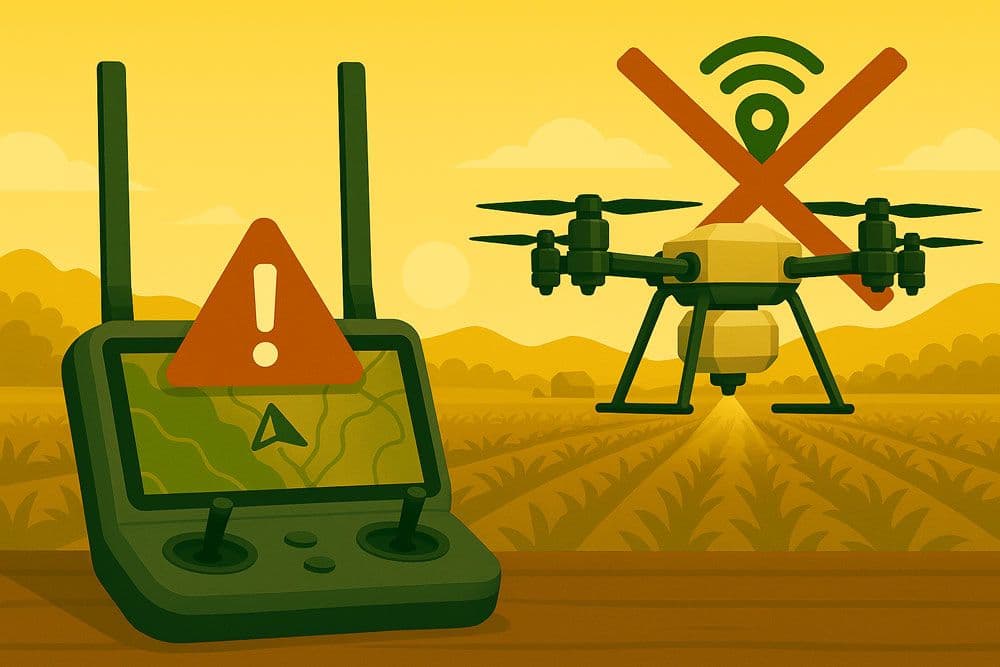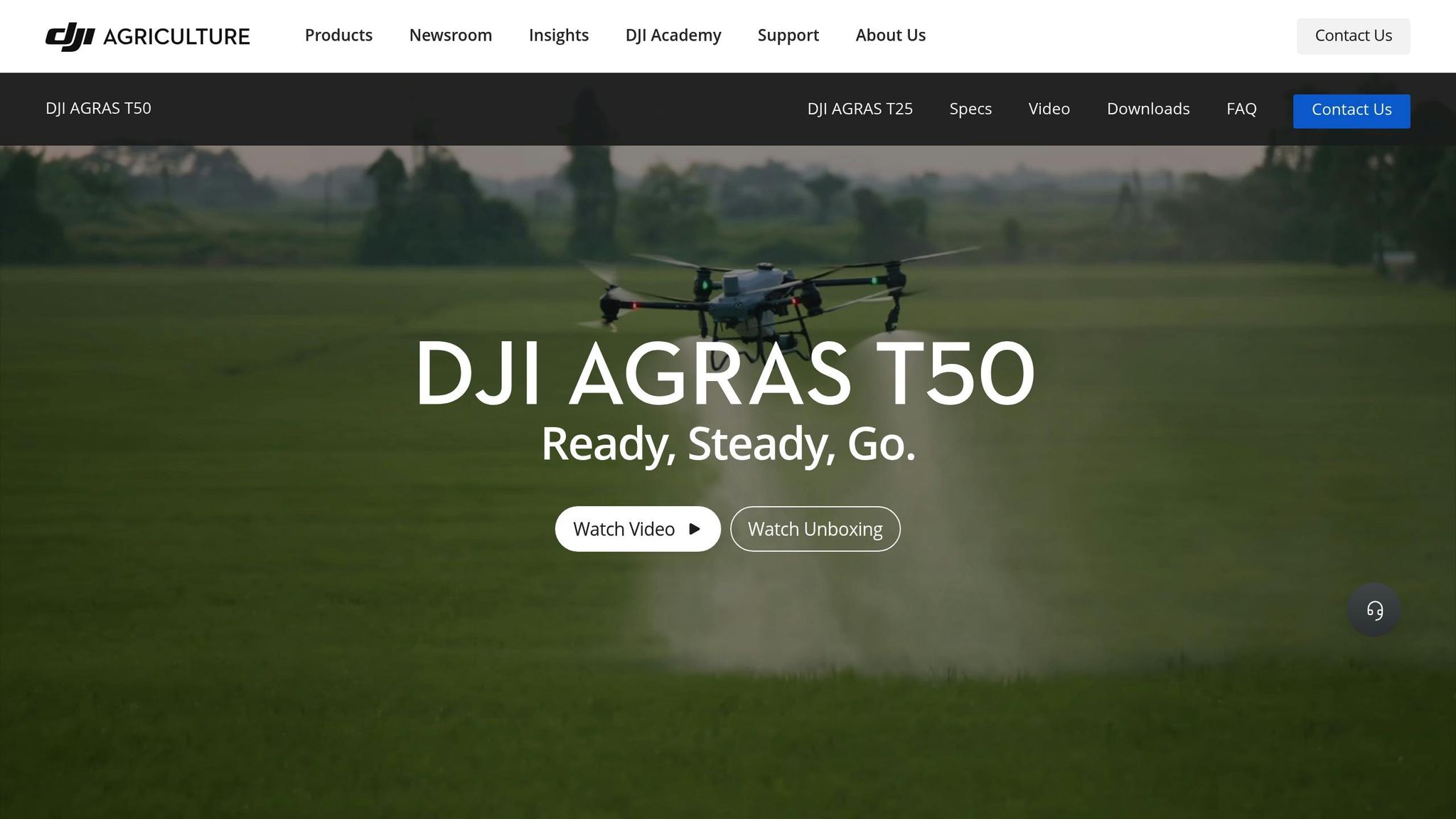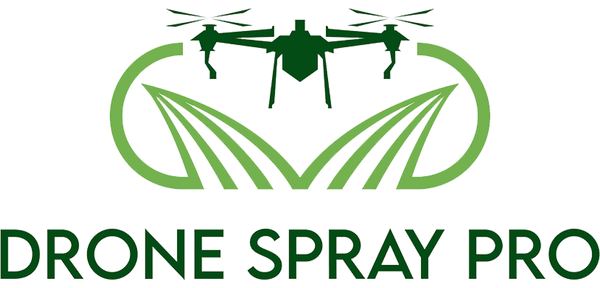
RTK Connectivity Problems: Solutions
Share
RTK technology ensures centimeter-level precision for agricultural drones, but connectivity issues can disrupt operations. Common problems include weak network signals, physical obstructions, and hardware setup errors. Here's how to tackle them:
- Network Signal Issues: Poor cellular coverage or network congestion can interrupt RTK corrections. Use stronger connections or position base stations strategically.
- Physical Interference: Trees, buildings, and weather can block or distort satellite signals. Avoid areas with obstructions and ensure a clear sky view for base stations.
- Hardware Problems: Loose cables, damaged antennas, or outdated firmware can compromise performance. Inspect and maintain equipment regularly.
Key Tips for Reliable RTK:
- Always check RTK status and signal strength before flights.
- Keep hardware clean, dry, and securely connected.
- Place base stations in open areas for optimal performance.
For persistent issues, professional support can help diagnose deeper problems or set up custom RTK networks tailored to your needs.
How to Connect to the RTK Network on a DJI AGRAS Drone

RTK Technology Basics and Benefits
Real-Time Kinematic (RTK) technology takes standard GPS to the next level by providing real-time error corrections, delivering centimeter-level accuracy. While your smartphone’s GPS might get you within a few feet of your destination, RTK achieves pinpoint precision - making it a game-changer for agricultural drones.
Here’s how it works: RTK calculates errors using data from a fixed reference station and the drone, both affected by similar atmospheric conditions. These corrections are transmitted in real time, ensuring the drone maintains highly accurate positioning throughout its flight.
This leap in precision significantly boosts the efficiency and dependability of agricultural drone operations. Let’s dive into the components that make RTK so effective.
RTK System Components
An RTK system relies on three key components:
- Base station: This serves as a fixed reference point, typically set up in a surveyed location. It continuously receives satellite signals and calculates positioning errors by comparing its known location to the satellite data.
- Rover unit: Installed on the agricultural drone, this unit processes both satellite signals and error corrections from the base station. Many modern drones come with built-in RTK modules or allow external systems to be attached for this purpose.
- Communication link: This connects the base station and the rover, transmitting correction data in real time. Communication can happen through radio frequencies, cellular networks, or internet connections. Radio and internet-based links are particularly effective for transmitting corrections over long distances.
A common method for delivering RTK corrections is NTRIP (Networked Transport of RTCM via Internet Protocol). This allows drones to receive corrections from permanent reference station networks, eliminating the need for a dedicated base station for every operation.
RTK Benefits for Agricultural Drone Operations
RTK technology offers agricultural drones a significant edge, thanks to its enhanced positioning accuracy. Precise navigation allows drones to optimize flight paths, minimizing overlaps and ensuring efficient chemical application while covering fields more effectively.
Accurate positioning also improves field mapping. Drones can map boundaries, identify obstacles, and analyze terrain with greater detail, enabling advanced automated flight planning. This means drones can fly closer to obstacles and structures while still maintaining safe and effective spray coverage.
Another major advantage is the ability to replicate flight paths with incredible accuracy. This consistency is crucial for repeat treatments during a growing season. By tying crop health data, yield maps, and field condition reports to exact geographic locations, farmers can make better-informed decisions for future treatments and overall field management.
Common RTK Connectivity Problems
While RTK technology offers impressive precision for agricultural drone operations, connectivity issues remain a common hurdle. These challenges can disrupt workflows and compromise accuracy, making it essential for operators to identify and resolve problems quickly.
Poor Network Signal or Coverage
One of the most frequent issues stems from weak cellular or data network signals, especially in remote farming areas where cellular towers are sparse. Drones using NTRIP connections to access correction data from reference station networks can lose RTK corrections when cellular coverage falters.
In rural areas, signal dead zones are a persistent challenge. Operators may begin with a strong connection only to lose it mid-flight, particularly during peak usage times when cellular networks are overloaded. Network congestion during these periods can slow or interrupt the data stream needed for real-time corrections. Since RTK relies on continuous communication between the base station and the rover unit, even brief interruptions force the system to fall back to less accurate positioning modes.
But network issues aren’t the only obstacles - environmental factors also play a significant role.
Environmental Interference
Physical barriers and weather conditions can significantly impact RTK performance. Tall structures, dense tree lines, and buildings can block or reflect satellite signals, leading to multipath errors where signals bounce off surfaces before reaching the drone’s antenna.
Electromagnetic interference from nearby power lines, radio towers, or industrial equipment further complicates connectivity. This type of interference is especially problematic near industrial zones or high-voltage lines running along field edges.
Weather also plays a role. Severe storms can temporarily degrade satellite signal quality and introduce delays. Although modern RTK systems are designed to handle most weather conditions, extreme weather events can still cause disruptions. Additionally, seasonal vegetation growth can create unexpected connectivity issues. For example, fields surrounded by tall crops or trees may experience reduced satellite visibility as vegetation reaches its peak height, even if connectivity was stable earlier in the season.
Beyond external conditions, hardware and setup problems can also hinder RTK connectivity.
Hardware or Setup Problems
Hardware issues often arise from physical damage or improper installation of key components. Loose or damaged antennas, mismatched communication settings, and outdated firmware are all culprits behind intermittent connectivity problems.
Another common issue is incorrect NTRIP credentials. Simple errors in host addresses, port numbers, usernames, passwords, or mountpoint details can block access to correction services. Without accurate credentials, operators are left without RTK functionality until the information is corrected.
Lastly, IMU calibration errors can impact overall system accuracy, even when RTK connections appear stable. If the Inertial Measurement Unit (IMU) isn’t properly calibrated, tilt correction may malfunction, leading to positioning inaccuracies. Error messages like "Initialize IMU" signal calibration issues that require immediate attention to restore precision.
RTK Connectivity Troubleshooting Steps
If you're facing RTK connectivity issues, start by giving your hardware a thorough check. A quick inspection can often reveal the root of the problem.
Look for Physical Damage
Carefully inspect your drone and RTK components for any visible signs of damage. Even minor cracks or dents can interfere with RTK performance, so pay close attention to these details.
Keep Components Clean
Dust and debris can wreak havoc on your drone's performance. Use an anti-static cloth and compressed air to clean the drone's chassis and RTK module. Regular cleaning helps ensure nothing obstructs the system's electronic functions.
Verify Connections and Fastenings
Double-check all cable connections and fastenings tied to your RTK system. Make sure everything is securely connected and free of corrosion or looseness, as these can disrupt connectivity.
If you need more help with RTK connectivity or advice on maintaining your agricultural drone, reach out to Drone Spray Pro for expert assistance. They can guide you in selecting and maintaining the right RTK accessories for your operations.
sbb-itb-3b7eef7
RTK Performance Best Practices
To maintain smooth RTK operations and avoid connectivity hiccups, it's crucial to adopt certain habits and routines. These practices can help you sidestep issues before they even arise.
Pre-Flight RTK Checks
Every pre-flight checklist should include a thorough RTK status review on your remote controller. Take a moment to check both the RTK status indicator and signal strength to confirm a stable connection before starting your spraying operations.
Ensure you have a solid satellite fix before takeoff - this reduces the risk of losing connectivity mid-flight.
Choosing the right location for takeoff and landing is equally important. Opt for spots with strong GNSS signal quality, steering clear of areas near large buildings, dense trees, or reflective surfaces like metal barns or water tanks. These obstacles can disrupt satellite signals, potentially leading to issues during critical spraying tasks.
If you're working with a base station, place it in a clear, open area with an unobstructed view of the sky. Double-check that it’s capturing all necessary GNSS constellations, such as GPS, GLONASS, Galileo, and BeiDou. For public base stations, make sure they’re within 25 miles of your flight area to maintain accuracy.
Confirm your USB modem’s SIM card is active and that the RTCM Corrections settings align with your service provider's requirements.
Once these pre-flight checks are complete, regular maintenance of your RTK hardware is the next step to ensure consistent performance.
RTK Hardware Maintenance
Routine inspections are key to avoiding hardware-related connectivity issues. Inspect RTK dongles and antennas monthly for any signs of wear or damage that could allow moisture to seep in.
Keep all RTK components clean and dry - dust, residue, or moisture can degrade performance over time. When not in use, store your RTK dongles and accessories in protective cases to shield them from environmental damage.
Before every flight session, check all cable connections to ensure they’re secure and free from debris or corrosion. Loose or oxidized connections are often the culprits behind intermittent connectivity problems.
Pay attention to your RTK dongle’s performance over time. A noticeable decline in signal strength across multiple flights could signal hardware wear and tear. Addressing these early signs can prevent unexpected failures during crucial spraying operations.
For added peace of mind, professional training and support can further enhance your RTK system's reliability.
Professional Support and Training
Drone Spray Pro offers specialized RTK training to help operators master hardware setup, improve workflows, and explore alternative correction methods like PPK. Their expert guidance also covers network selection, NTRIP credential configuration, and adapting to evolving system updates - ensuring you stay ahead as technology changes. With their ongoing support, you can maintain dependable RTK performance for all your operations.
When to Get Professional Help
While basic troubleshooting can resolve many RTK connectivity problems, there are times when calling in the experts is the smartest move. Knowing when to seek professional help can save you precious time during busy spraying seasons and help avoid costly equipment damage.
Persistent RTK Connection Issues
If your RTK connection keeps failing despite your best troubleshooting efforts, it’s time to call in professional support. Repeated connection problems across multiple flights often point to deeper issues that go beyond routine maintenance. These could include network configuration errors, incompatibility between your drone’s RTK system and correction services, or even hidden hardware issues.
During peak spraying periods, every hour of downtime means missed opportunities to complete critical work. Professional technicians have the tools and experience to pinpoint the problem quickly - saving you days of trial and error. Whether it’s a network glitch, a compatibility issue, or a hardware malfunction, they can get you back up and running fast.
Intermittent connection problems with no obvious pattern can be especially tricky. These might be caused by electromagnetic interference, minor antenna malfunctions, or network routing issues that require advanced diagnostic techniques. If these recurring issues persist, it’s time to shift from DIY troubleshooting to professional intervention.
Hardware Repairs or Replacement
When RTK components are physically damaged, professional expertise becomes essential to determine whether repair or replacement is the best course of action. While minor wear and tear can often be addressed with regular maintenance, significant damage usually involves internal components that require specialized tools and knowledge.
For example, RTK dongles showing weak signal strength despite proper cleaning and positioning might have internal antenna damage or circuit board issues. A professional can identify whether the problem lies with the dongle, the drone’s RTK receiver, or their connection.
Moisture intrusion or water damage is another red flag that demands immediate attention. Even if the equipment seems fine after drying, hidden corrosion can lead to future failures. Professionals can assess the damage, identify potential risks, and recommend preventive measures.
If your RTK hardware fails during the warranty period, a professional diagnosis ensures proper documentation for warranty claims. Attempting DIY repairs could void your warranty and lead to unnecessary expenses.
For more complex RTK challenges that go beyond individual hardware issues, you might need a custom RTK network.
Custom RTK Network Setup
Large-scale operations often benefit from custom RTK network setups to achieve optimal performance. Professionals can handle everything from base station placement and network coverage analysis to integrating the system with your farm management tools.
If your operation requires sub-inch precision for specialized tasks, standard correction services might not cut it. Professional consultants can design and implement dedicated base station networks tailored to your specific accuracy needs and workflows.
Integrating RTK with precision agriculture systems, such as variable rate application controllers or automated guidance systems, often involves multiple technologies. Professionals ensure all components work together seamlessly, maintaining the centimeter-level accuracy that makes drones so effective in agriculture.
Drone Spray Pro’s technical team specializes in creating custom RTK solutions for complex farming setups. From planning and base station installation to ongoing optimization and troubleshooting, they ensure your system performs flawlessly across varying terrains and operational demands.
Conclusion: Maintaining RTK Connectivity for Agricultural Drones
Ensuring stable RTK connectivity is key to achieving the centimeter-level accuracy needed for precision spraying tasks. Whether you're targeting specific weed patches or ensuring even coverage over large fields, a dependable RTK connection plays a critical role in maximizing efficiency and improving crop outcomes.
By following systematic troubleshooting steps, many connectivity issues can be resolved quickly. Performing regular pre-flight RTK checks and staying on top of hardware maintenance helps prevent disruptions before they occur, ensuring smooth operations during crucial agricultural windows. If basic troubleshooting doesn’t solve the problem, seeking expert support is the next logical step.
Persistent RTK connection failures may point to deeper hardware issues or configuration errors that require advanced tools and expertise to address. For larger-scale operations, especially those needing custom RTK networks, professional consultation can be invaluable. Experts can assist with optimal base station placement and the integration of multiple precision technologies to meet the demands of sub-inch accuracy.
Investing in high-quality RTK hardware, consistent maintenance, and professional support not only minimizes spray drift but also enhances coverage and operational efficiency. These steps are essential for leveraging the full potential of agricultural drones in modern farming.
FAQs
How can I set up a base station to ensure reliable RTK connectivity for agricultural drones?
To ensure dependable RTK connectivity, position your base station in an open space with a clear, unobstructed view of the sky. This setup minimizes interference and supports accurate satellite communication. For optimal performance, keep the base station within about 22 miles (35 kilometers) of your drone’s operational area to maintain precise RTK corrections.
Make sure the base station is firmly connected to a stable power source and situated away from interference sources like tall buildings or dense clusters of trees. Following these guidelines will help enhance RTK performance and improve the accuracy of your drone during agricultural tasks.
What can I do if electromagnetic interference is disrupting my drone’s RTK connectivity?
Electromagnetic interference (EMI) can mess with your drone’s RTK connectivity. This often happens near power lines, radio towers, or other electronic devices. You’ll notice EMI issues if your drone’s signals become unstable or experience interruptions in specific locations.
To fix this, try moving your drone to a spot farther away from any potential EMI sources. You can also take steps like shielding sensitive parts, improving grounding, or using filters designed to reduce interference. If you’re working with agricultural drones, like those from Drone Spray Pro, make sure the RTK dongles are properly set up and maintained to keep connectivity strong.
When should I contact a professional for ongoing RTK connectivity issues, and what help can I expect?
If you've already gone through the basics - like checking your hardware, upgrading antennas, or tweaking settings to account for environmental factors - but your RTK connectivity issues are still hanging around, it might be time to call in a professional. Ongoing problems could point to more complex issues that need expert attention.
Professionals can dive deeper into diagnosing hardware or network configuration problems, fine-tuning signal strength, and tackling interference caused by environmental conditions. They can also help you explore alternative correction methods, such as PPK, to keep your drone running smoothly and reliably. This expertise can save you valuable time and boost efficiency, especially when working on tasks like precision agriculture or crop spraying.
